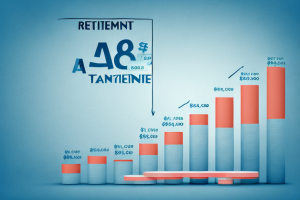Retirement planning can be a complex and overwhelming process. With numerous factors to consider, such as income, expenses, and investment returns, it’s crucial to have a solid strategy in place. One popular retirement planning approach that has gained significant attention in recent years is the 5 retirement rule.
Understanding the basics of retirement planning
Before delving into the intricacies of the 5 retirement rule, it’s essential to have a basic understanding of retirement planning as a whole. Retirement planning involves determining the amount of money needed to sustain your desired lifestyle once you stop working. This includes factoring in expenses such as housing, healthcare, food, and leisure activities. To achieve this, retirees typically rely on a combination of savings, Social Security benefits, and investment returns.
Planning for retirement requires careful consideration of several factors, including the desired retirement age, anticipated lifespan, and expected rate of return on investments. The goal is to have enough savings and income to maintain financial stability and independence throughout your retirement years.
The 5 retirement rule explained: A comprehensive overview
The 5 retirement rule is a popular retirement planning strategy that suggests individuals should aim to accumulate a savings pot that is five times their annual income by the time they retire. For example, if someone earns $50,000 per year, the goal would be to have $250,000 in savings at retirement.
The premise behind the 5 retirement rule is to provide individuals with a benchmark to ensure they have adequate savings to sustain their lifestyle during retirement. It aims to strike a balance between being achievable for most individuals and providing a reasonable income replacement ratio.
How the 5 retirement rule can help you plan for your golden years
By adopting the 5 retirement rule, individuals can set a tangible goal for their retirement savings. This approach offers a straightforward calculation that can act as a guiding principle throughout their working years. It also helps to alleviate the uncertainty and stress often associated with planning for retirement.
Setting a specific savings target, such as five times your annual income, helps individuals determine how much they need to save on a regular basis. It encourages proactive financial management, budgeting, and disciplined saving habits. By following this approach, individuals can work towards accumulating a sizable retirement nest egg that aligns with their income level and desired lifestyle during retirement.
Why the 5 retirement rule is gaining popularity among retirees
The 5 retirement rule has gained popularity among retirees due to its simplicity and feasibility. Unlike more complex retirement planning strategies, the 5 retirement rule offers a straightforward calculation that is easy to understand and implement. This accessibility makes it appealing to individuals who may not have advanced financial knowledge.
Additionally, the 5 retirement rule provides retirees with a sense of financial security. By striving to accumulate a savings pot that is five times their annual income, individuals can feel confident that they have a strong foundation in place to support their retirement lifestyle. This rule of thumb allows retirees to focus on enjoying their golden years rather than constantly worrying about their financial well-being.
Breaking down the components of the 5 retirement rule
When discussing the 5 retirement rule, it’s crucial to understand the key components that contribute to its effectiveness. The rule is based on three main factors: desired retirement age, anticipated lifespan, and expected rate of return on investments.
The desired retirement age refers to the age at which individuals aim to stop working and transition into retirement. This determines the number of years they have to accumulate savings and achieve their target amount. Anticipated lifespan helps to estimate how long retirement savings will need to last. Factors such as health, genetics, and lifestyle choices can influence life expectancy.
The expected rate of return on investments plays a significant role in determining how much individuals need to save. A higher expected rate of return could potentially allow for lower savings targets, while a lower expected rate of return may necessitate higher savings goals.
Is the 5 retirement rule suitable for everyone?
While the 5 retirement rule offers a helpful starting point for retirement planning, it may not be suitable for everyone. Individual circumstances, such as income level, lifestyle preferences, and risk tolerance, need to be taken into account.
Higher-income individuals may require a higher savings multiple to ensure they can maintain their desired lifestyle during retirement. On the other hand, those with a lower income may find it challenging to reach the five-times savings target and may need to adjust their expectations or consider alternative strategies.
Pros and cons of following the 5 retirement rule
Following the 5 retirement rule has its share of advantages and disadvantages. Let’s explore both:
Pros:
- The rule is simple and easy to understand.
- It provides a tangible savings target.
- Individuals can adjust their savings habits accordingly.
- Financial peace of mind during retirement.
Cons:
- It doesn’t account for variations in income levels.
- Individuals with higher expenses may need more savings.
- Relies on the assumption of a steady rate of return on investments.
Tips for implementing the 5 retirement rule effectively
Implementing the 5 retirement rule effectively requires a proactive and disciplined approach. Here are some tips to help you succeed:
1. Start early: The sooner you start saving for retirement, the more time your investments have to grow. Time is a crucial factor in accumulating the desired savings pot.2. Consistent saving: Establish a regular savings habit by setting aside a portion of your income each month. Automate your savings, if possible, to make it a seamless process.3. Review and adjust: Continually reassess your progress towards your savings goal. Life circumstances and financial situations change, so it’s important to adapt your strategy as needed.4. Seek professional advice: Consider consulting with a financial advisor who specializes in retirement planning. They can provide personalized guidance and help optimize your strategy.5. Diversify your investments: To mitigate risk, diversify your investment portfolio across different asset classes. This can help protect your savings and potentially enhance returns.6. Regularly track your expenses: Monitoring your expenses allows you to make informed financial decisions and identify areas where you can cut back or save more.
Common misconceptions about the 5 retirement rule debunked
Like any retirement planning strategy, the 5 retirement rule is not immune to misconceptions. Let’s debunk some common myths:
Myth 1: It guarantees financial security: While the rule provides a useful benchmark, it doesn’t guarantee absolute financial security. Other factors, such as unexpected expenses or changes in the economy, can affect retirement savings.Myth 2: It applies universally: The rule may not apply equally to everyone. Individual circumstances, such as income level, lifestyle preferences, and risk appetite, should be considered.Myth 3: It’s a one-size-fits-all solution: The 5 retirement rule is just one approach among many. It’s important to explore alternative strategies and find the one that aligns best with your personal financial goals and circumstances.
Case studies: Real-life examples of successful implementation of the 5 retirement rule
Real-life case studies can provide valuable insights into the practical application of the 5 retirement rule. These examples showcase how individuals have achieved their retirement savings goals by following the rule diligently.
Case study 1: Jennifer, a 45-year-old accountant, began saving for retirement early in her career. She consistently set aside a portion of her income and adjusted her savings contributions over time. By the time she turned 65, Jennifer had accumulated a savings pot that was five times her annual income. This allowed her to retire comfortably and enjoy her desired lifestyle without financial worries.
Case study 2: Michael, a 55-year-old teacher, started saving for retirement later in life due to various financial obligations. However, he adopted strict budgeting practices, reduced discretionary expenses, and increased his savings rate significantly. Through diligent saving and moderate investment returns, Michael managed to reach his retirement savings goal of five times his annual income just before his planned retirement age.
Adjusting the 5 retirement rule to fit your personal financial goals
While the 5 retirement rule provides a suitable starting point, it’s essential to adjust it to align with your specific financial goals and circumstances. The rule can act as a baseline, but individual factors such as income, expenses, and desired lifestyle will dictate the necessary adjustments.
How to calculate your target savings using the 5 retirement rule formula
To calculate your target savings using the 5 retirement rule, follow these steps:
1. Determine your annual income: Calculate your current annual income or estimate your future annual income based on your career trajectory.2. Multiply by five: Multiply your annual income by five to determine your target savings amount.3. Consider investment returns: Adjust your target savings amount based on your expected investment returns. A higher expected rate of return may allow for lower savings targets, while a lower expected rate of return may necessitate higher savings goals.
Exploring alternative strategies to supplement or replace the 5 retirement rule
While the 5 retirement rule is a viable strategy, it’s not the only option available. Individuals may choose to supplement or replace this approach with alternative strategies that better suit their financial goals and risk tolerance.
Some alternative strategies include:
- Percentage-based savings plans: Instead of focusing on a specific multiple of their income, individuals can save a certain percentage of their income towards retirement.
- Retirement income replacement ratios: This approach calculates the percentage of pre-retirement income needed during retirement and sets savings goals accordingly.
- Retirement calculators: Online retirement calculators can help individuals estimate their retirement savings needs based on various factors such as income, expenses, and retirement age.
Key considerations before adopting the 5 retirement rule as your primary savings strategy
Before fully embracing the 5 retirement rule as your primary savings strategy, carefully consider the following factors:
1. Income variability: If your income fluctuates significantly, the 5 retirement rule may not accurately reflect your retirement needs. In such cases, it’s important to reassess your savings goals periodically.2. Lifestyle preferences: Your desired retirement lifestyle may require a higher or lower savings target than what the 5 retirement rule suggests. Factor in your individual preferences and adjust accordingly.3. Other sources of retirement income: If you have other sources of retirement income, such as a pension or rental income, you may need to adjust your savings goal accordingly to account for these additional funds.
Navigating potential challenges when following the 5 retirement rule
Following the 5 retirement rule may come with its fair share of challenges. Here are a few potential obstacles to be aware of:
1. Market volatility: The 5 retirement rule assumes a steady rate of return on investments. However, market fluctuations can impact investment performance and, consequently, your savings progress. Plan for these uncertainties and adjust your strategy accordingly.2. Unexpected expenses: Unexpected expenses, such as medical bills or home repairs, can put a strain on your retirement savings. It’s important to have an emergency fund in place to cover such unforeseen costs without derailing your retirement plans.3. Inflation: Inflation erodes the purchasing power of your savings over time. Be mindful of inflation rates and consider adjusting your savings goals periodically to account for its impact.
Strategies for maximizing your savings potential under the 5 retirement rule
To maximize your savings potential under the 5 retirement rule, consider implementing the following strategies:
1. Increase your savings rate: Look for opportunities to increase your savings rate over time. As your income grows or expenses decrease, allocate the surplus to your retirement savings.2. Minimize unnecessary expenses: Review your expenses and identify areas where you can cut back. Prioritize your retirement savings over discretionary spending to accelerate your progress towards your goal.3. Take advantage of employer benefits: If your employer offers matching contributions to a retirement savings account, be sure to contribute enough to maximize their matching benefits. This effectively boosts your savings without affecting your take-home pay.
How to stay on track with your retirement goals using the 5 retirement rule
To stay on track with your retirement goals using the 5 retirement rule, consider the following tips:
1. Regularly review your progress: Continually review your savings progress to ensure you’re on track to reach your target amount. This allows you to make any necessary adjustments along the way to keep yourself on course.2. Automate your savings: Set up automatic transfers from your paycheck to your retirement savings account. This ensures consistency and takes the burden of remembering to save off your shoulders.3. Seek regular financial check-ups: Regularly meet with a financial advisor to assess your retirement planning strategy, investments, and overall financial health. Their expert guidance can help fine-tune your approach and address any areas of concern.
The role of investments in achieving success with the 5 retirement rule
Investments play a vital role in achieving success with the 5 retirement rule. They allow individuals to grow their savings over time through compounding and potentially earn higher returns than traditional savings accounts.
While the exact investment strategy will vary based on individual circumstances and risk tolerance, some common investment options to consider include:
- Stocks and mutual funds: Investing in stocks and mutual funds allows individuals to participate in the growth potential of the stock market.
- Bonds: Bonds tend to be less volatile than stocks and can provide a stable income stream during retirement.
- Real estate: Real estate investments, such as rental properties or real estate investment trusts (REITs), can generate consistent cash flow and potential capital appreciation.
- Retirement accounts: Maximize the use of tax-advantaged retirement accounts such as 401(k)s or IRAs to benefit from tax savings and potential employer contributions.
Expert advice and insights on optimizing your financial future with the 5 retirement rule
Opt



